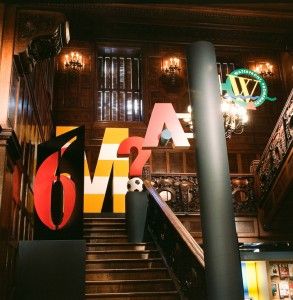What will the car of the future look like? Given America’s love affair with dressed-up trucks, will the new cars be lightweight tractor-trailers or luxury bulldozers with overdrive?
Dream on America. The car of the future is not designed for you. The car of the future is for the rest of the world, people who are not consumed with fantasies of driving up stream beds, but simply want to get from point A to point B with a reasonable degree of efficiency, comfort, and style.

Nine of these cars are parked right now in the Museum of Modern Art’s Sculpture Garden for a show titled “Different Roads: Automobiles for the Next Century.” In fact, they are not really so futuristic. Most of them are being driven already or will be in a few months, either here, in Japan, or in Europe.
The cars in this show have electric engines, or combination electric and internal combustion. They are made of lighter materials such as aluminum or composites of plastic and metal. Some of them have a half or a quarter the number of parts of conventional cars, and several position the engine neither in front, nor in back, but underneath the passenger compartment.
Carmakers envision these autos making the commute into Peking or New Delhi – car ownership in China and India is expected to skyrocket in the next 10 years – or slipping into minuscule parking spaces in Caracas or Sao Paulo, cities where gridlock is so bad that people can only drive their cars on alternate days.
Most of the cars are small – some very small – and they range in appearance from the sleek and streamlined to utilitarian boxes.
The most outrageously scrunched of the bunch is the – “Smart Car,” which is 8 foot 2 inches long and was developed by the Swatch watch company and Mercedes Benz. To American eyes it doesn’t look quite serious – more like some kind of “autopod” that is used to shuttle across the mall parking lot. Like the Swatch watch, the car is meant to be affordable and easily customizable. It has proved popular in Europe, especially with young people who like its multicolored dashboard and controls and the removable body panels that allow for a quick and cheap color change.
Despite its diminutive size, it has several safety features – front and side air bags, and a reinforced metal frame around the passenger compartment.
Daimler Chrysler’s Composite Concept Vehicle was specially designed for developing nations. “Our initial direction was to develop a car that was as easy to assemble as a toy,” said Chrysler executive Francois Castaing. Hence, the car has only one quarter the number of parts of a typical car and the entire vehicle splits down the middle, front to back, and is assembled with four bolts and adhesive.
Because of its simplicity, factory assembly takes only 6 1/2 hours. Instead of having a painted finish, the car’s body is molded in color – just like a telephone, coffee maker, or other plastic object. It weighs a mere 1,200 pounds, hence requires only a two-cylinder engine, and, in anticipation of the bumps and gullies of roads in developing countries, it has a high wheel clearance of 8 inches.
Although some of the cars in the show are two-seaters, designed for young people or commuters, The Fiat Multipla Bipower – introduced in 1998 – is a family car, with a spacious interior despite a moderate length of only 13 feet. Its 6-foot width allows for three bucket seats both in the front and the back, and its unusual height gives it a spacious feel. The car is engineered in two parts: a lower section contains the engine and drivetrain, and the tall upper section is for passengers and cargo. In case of an accident, the lower section of the car is supposed to bear the brunt of the impact. To improve visibility, the car has headlights and taillights that are placed at three different heights on the body.
The “Bipower” aspect refers to an engine that can use regular gasoline or methane, which is less polluting. It has two tanks and can alternate between the two fuels.
Toyota and Honda have produced cars that are hybrid-powered – both electric and gasoline engines. The Honda VV, available in a few months here and in Japan, is a two-seat subcompact with a three-cylinder gasoline engine and an electric motor as its secondary power source. A computer decides which one should be used, depending on the driving situation. Its lightweight aluminum space frame and composite body panels give it an average fuel economy of 70 miles per gallon, giving it the ability to go 700 miles on a single tank – the distance from New York to Detroit.
Toyota’s Prius, which has been available in Japan since 1997, is the most conventional looking of the cars. Like the Honda, it has computer-controlled, alternating gasoline and electric engines. Because it relies more on the electric motor in stop-and-go traffic, it gets its best gas mileage under those conditions.
Fully electric cars produce no emissions, but have the disadvantage of a limited driving range between recharges. The General Motors EV1 has been around since 1995. It is the most aerodynamically sleek of the cars, with rear wheels that are 9 inches closer together than the front ones, giving it a teardrop shape. The EV1 can go approximately 50 to 70 miles before its batteries need recharging. This can be done in three hours at specially equipped stations, but takes 12 to 16 hours at home using a portable unit.
The prize for the most weirdly named car goes to the Ford Ka. That is what the ancient Egyptians called the soul, the entity that was preserved by mummification practices. The Ford Company uses the more upbeat, modern translation of “vitality.”
Introduced in Europe and South America in 1996, the bubble-shaped subcompact – smaller than the Fiesta or Escort – gets 48 miles per gallon.
The clunkiest looking of the cars is the boxy Audi Al2. It has a number of electronic gizmos, such as photo-sensors for parking and an automatic distance control that alerts drvers when they are getting too close to the car ahead.
The history of automobile design in America has been as much about status as practicality. Americans have never gotten over the love of big cars, whether it was the big boats of the Fifties that hogged the road or the up-on-stilts SUVs of the Nineties that allow their occupants to look down on all the little people. Barring another fuel crisis here, that’s not likely to change. But as carmakers set up factories specfically for these practical cars, the volume of sales worldwide could create “universal” cars that would be so cheap, they would make inroads even here.
The Museum of Modern Art
1999




